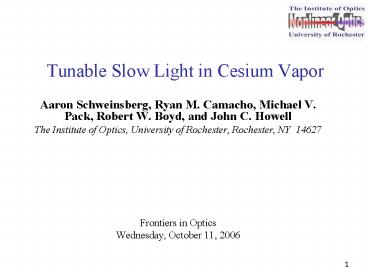Tunable Slow Light in Cesium Vapor - PowerPoint PPT Presentation
1 / 12
Title:
Tunable Slow Light in Cesium Vapor
Description:
Density of cesium atoms in the cell ... Pump turn-on time of 100 ns (as switched by AOM) ... Higher pump powers could reduce reconfiguration time. 11. Summary ... – PowerPoint PPT presentation
Number of Views:51
Avg rating:3.0/5.0
Title: Tunable Slow Light in Cesium Vapor
1
Tunable Slow Light in Cesium Vapor
- Aaron Schweinsberg, Ryan M. Camacho, Michael V.
Pack, Robert W. Boyd, and John C. Howell - The Institute of Optics, University of Rochester,
Rochester, NY 14627 - Frontiers in Optics
- Wednesday, October 11, 2006
2
Slow light
- Goal obtain large pulse delays for
high-bandwidth pulses - The group velocity of a pulse is given by
- We can obtain exceptional pulse propagation
speeds in spectral regions where refractive index
changes rapidly with frequency (high dispersion). - We desire a region where dn/dw is large, but also
constant over the bandwidth of the pulse.
3
Slow light in atomic vapors
- Need dn/dw large, over a large bandwidth.
- This condition can be met in the region between
the absorption resonances of the ground-state
hyperfine levels in an atomic vapor. - Working far from resonance, we find that pulse
distortion is dominated by group velocity
dispersion, rather than absorption.
4
Theory (cont.)
- (a) - absorption spectrum showing 10 GHz ground
state hyperfine splitting in cesium (can
accommodate wide bandwidth pulses) - (b) - associated index profile and group velocity
5
Experimental Setup
- 852-nm diode laser is tuned between the hyperfine
resonances. - Density of cesium atoms in the cell controlled by
heater - Delay can also be tuned by application of
resonant pump beams
6
Pulse delay through cesium vapor
- Delay adjusted by changing cell temperature.
Temperatures ranged from 90 C to 120 C. - 275 ps pulses delayed by up to 25 times the input
pulse duration. - Useful delay limited by dispersive broadening.
7
Delay through cesium (740 ps input)
- There is a trade-off between broadening and
delay. - If we allow only minimal broadening, fractional
delay can be greater for longer input pulses. - 740 ps pulses can be delayed up to 80 times their
initial width! - Three 10-cm Cs cells were used in series.
Temperatures ranged from 110 C to 160 C.
8
Measurements of broadening
- Broadening data for delayed 740 ps pulses
- Fractional broadening, defined as (T - T0) / T0,
never exceeds 0.6. - Useful delay is likely to be limited by the
reduction of the peak pulse height due to
dispersive broadening.
9
Rapid tuning of the delay
- Delay can be tuned by applying strong pump fields
directly to the resonances. - Optical pumping reduces the effective number
density of Cs atoms seen by the signal. - Used a 80 MHz AOM to turn two resonant 30 mW pump
beams on and off - Delay of a pair of 275 ps pulses altered by 1 ns,
equal in this case to the initial pulse
separation. (one bit slot)
10
Measuring the switching speed
- Pump turn-on time of 100 ns (as switched by AOM)
- Reconfiguration of delay takes place over 700
ns. - Higher pump powers could reduce reconfiguration
time.
11
Summary
- We can produce slow light in the high-dispersion
spectral region between the ground-state
hyperfine resonances of an atomic vapor. - Obtained delays much longer than the input pulses
duration for high-bandwidth pulses. - 275 ps pulses - fractional delay of 25
- 740 ps pulses - fractional delay of 80
- Demonstrated rapidly tunable (700 ns) delays of 1
ns for sequential 275 ps pulses. - Support for this work has been provided by the
slow light program of DARPA / DSO
12
Outline
- Theory of slow light in cesium vapor
- Large delay of high-bandwidth pulses
- The effects of pulse broadening
- Tuning the pulse delay
- Conclusion































